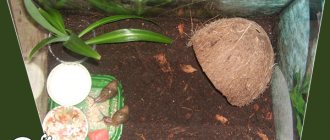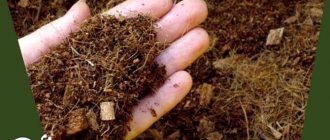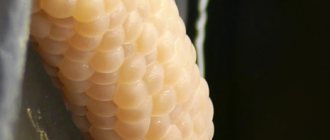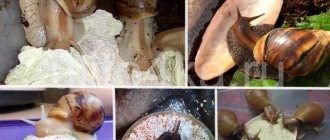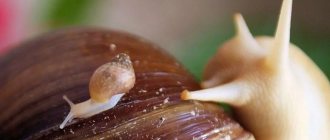Achatina snails are land mollusks. Originally from tropical countries. African mollusks cannot live in nature in our latitudes, so those who love exotic animals raise and keep large Achatina at home. What does a snail need for a comfortable stay? A cozy home, delicious food and proper care.
How to build a terrarium for “Akhatinki” yourself
These mollusks like a subtropical, temperate climate, and even a slight drop in temperature can cause their death. Therefore, owners must provide their pets with suitable conditions. In addition, Achatina requires a special tank - a terrarium, in which it is necessary to reproduce with maximum accuracy the environment familiar to these animals.
Many owners of Achatina use a regular aquarium; in it you can create an excellent imitation of natural conditions. In such a tank, the snail will be protected from drafts and cold air, it will remain at room temperature and it will be easy to maintain suitable humidity. The owner should be wary if his ward has become inactive - in this case, there is a risk of death of the Achatina, and most often this happens due to the inattentive attitude of the owner.
Feeding regimen and diet
An important aspect of keeping giant snails is that if the pet does not get everything it needs, it will get sick and die. Achatina should not be given:
- acid;
- calcium;
- salt,
- sour foods, confectionery and flour products;
- potato;
- green tomatoes;
- sweet foods and drinks;
- smoked meats;
- roast.
In their natural environment, these snails eat almost everything - from rotting plants to citrus bark. They grind food with a tongue covered with spines with a keratinized surface. They do not refuse carrion, mushrooms, algae, and lichens. At home, Achatina is fed with melon, pumpkin, greens, salad plants, sunflowers, eucalyptus leaves, legumes, onions, potatoes, spinach, and young corn.
It is useful to give your pets shoots of cereals and vegetables, tops from beets and carrots. You can also diversify your pet’s menu with young birch, linden, apple or oak leaves, freshly squeezed juice from pumpkin, carrots, peach, pear.
It is worth noting that young animals of this breed love to eat living vegetation, while adults prefer rotting remains. Many owners have real picky eaters waiting for something “tastier.” But usually such behavior can be corrected, and, without waiting for a tasty bonus, Achatina begins to eat what the owner offered them.
Until recently, Achatina in Russia was truly exotic. Sellers quickly sold these overseas inhabitants, and the army of fans of giant snails grew steadily. Today, many people keep these mollusks and even produce offspring, which confirms that caring for them is not as difficult as it seems.
An ideal terrarium for Achatina snails
Many factors are important - from the size of the tank to its decor - after all, we are not talking about ordinary, but about exotic mollusks:
- When calculating the volume of the tank, it should be taken into account that one clam requires at least 10 liters. It is worth immediately taking into account that, although in captivity Achatina does not grow to the same gigantic size as in the natural environment, they are still quite large snails;
- for a 30-liter container, a couple of Achatina are enough - however, if they live in comfort, then you won’t have to wait long for the appearance of offspring;
- such a pet will not run away, but it may well crawl out of the tank, so it is advisable to provide it with a lid with holes - this will provide both protection and ventilation;
- the ideal size of a house for snails is a height of at least 20 cm, a width of 35 cm;
- direct sunlight is harmful to Achatina, they can lead to the death of the pet, so the terrarium should be installed in a dark place;
- in a terrarium or aquarium, the bottom should be covered with a layer of soil - moss and coconut substrate are ideal for snails;
- Achatina should have several feeders - everyday food is placed in one, additional feeding is placed in the others: a grain mixture, a composition with eggshells, feed chalk, rolled oats, etc.;
- There must be a container for swimming - made of plastic material, with low sides and a small volume of water so that the snail does not choke (it will not splash or dive, it just enjoys being in the water);
- all tanks, bowls, etc. should be secured, otherwise the snail may turn everything over with an awkward movement;
- in order to maintain and monitor readings of temperature, humidity and other parameters, the container must be equipped with a thermometer, hydrometer and other instruments;
- The terrarium requires weekly general cleaning; to maintain constant cleanliness, you can prepare a sponge with good absorbent properties.
Special attention should be paid to the soil, as it performs several important functions at once:
- maintains humidity in the tank - to do this, it is enough to spray it 2-3 times during the day;
- many Achatina prefer to rest during the day, buried in the soil - therefore its layer should be thick enough and the consistency should be loose;
- the substrate is also a place for laying eggs - it makes the future offspring cozy and warm;
- the soil eliminates cases of injury to snails when they slide off the walls or lid of the tank and fall to the bottom (it often happens that when falling from a height, Achatina’s shell breaks and the animal dies).
Types of soil
To make living conditions comfortable, you need to know how to equip the utilitarian from the inside. The soil should have a thickness of 6-7 cm and be loose and soft in consistency. This will help avoid chips and cracks if the animal accidentally falls from the walls of its home.
Suitable
Best options for soil:
- moss is one of the favorite bedding options for mollusks;
- peat is a budget option, good in combination with other types of soil;
- fallen leaves - can be an independent or additional option;
- coconut substrates are inexpensive and most popular;
- bark of certain types of trees;
- earth with low acidity (as for violets).
Soils that can store moisture well and allow the mollusk to burrow inside are also suitable.
Prohibited
Sawdust and sand are strictly prohibited. The former very quickly oxidize the mollusk shell. Because of this, the shell becomes covered with a white coating, which is extremely difficult to clean off. Sand can also cause scratches on the shell. But it is most dangerous when swallowed with food; it may not completely exit the esophagus.
Read more about choosing soil for Achatina snails in this article.
Container as a terrarium
Many Achatina owners take the simple route and keep their African charges not in terrarium aquariums, but in plastic boxes. How suitable is such housing for exotic snails? As it turns out, a container is an excellent option when it comes to a 30-40 liter container. The ideal option is a transparent box with a removable lid and holes that provide adequate ventilation.
The minimum height of the walls of the tank is 20 cm, length - 30 cm. Naturally, if the owner is going to breed Achatina, he should take care of a spacious house for his inhabitants, the number of which will increase over time.
As in a terrarium, the container must be maintained at a certain humidity level and the container should not be placed in the sun. In no case should shellfish bask in direct sunlight - this will cause dehydration of the animal and its death.
If the snail's house is an ordinary container, a box should be placed in it, the bottom of which should be covered with substrate. The thickness of the substrate layer for large snails should be at least 10 cm.
For these purposes, you can buy a package of special soil or loose sand at a pet or gardening store. When choosing a suitable substrate, you should focus on the pH of the composition, which is usually indicated on the package. It is best if this indicator is 7.0. If you place soil with low acidity in a tank containing snails, this can damage the skin or shells of the inhabitants.
If soil from your own garden plot is used as soil, it must first be sterilized - in a hot oven or refrigerator. Otherwise, infection or parasites may enter the house.
Where to place
These pets are not very picky about environmental conditions, but the minimum parameters must still be observed. Otherwise, the individuals will feel uncomfortable and will most likely die. They like quiet places, protected from pets and sunlight. It is advisable to place it in rooms with high humidity and sufficient temperature. The box must contain a substrate for the substrate.
Adults prefer a deep base - at least 7 centimeters. It is best to use ready-made soil options, which are sold in gardening stores; such soil does not contain harmful impurities. You need to check in advance such an important parameter of the substrate as pH (it will be written on the packaging). A pH level of 7.0 will be sufficient; lower values will negatively affect the condition of sensitive skin and sinks.
Setting up a snail house
The owner of African snails can approach the issue creatively and independently arrange the home of his pets. In this case, you can think of comfortable conditions for both daytime and nighttime recreation.
The basis of a homemade house can be pottery shards, pebbles, and shells. You can line one part of the tank with soil, the other with decor, since some of the Achatina love soil, while others have a weakness for stones. Already while observing the mollusk, the owner will be able to understand its preferences.
You can use a small saucer as a container for water; the snail can climb into it without the risk of drowning. It is advisable to plant the terrarium with living vegetation - ivy, ferns, moss. These plants thrive in environments with high humidity. Ivy is an excellent solution for modest-sized containers.
Plants and accessories
Decorating a tank with snails allows you to realize numerous creative ideas of the owners. You can decorate the space using a variety of branches, driftwood and cones, combined into unusual compositions. The components must be disinfected if we are talking about objects assembled with one’s own hands, or simply purchased at a specialized store. You can also arrange the tank using beautiful moss - either decorative or forest. Again, the moss that you collect yourself must first be soaked for half a day in cool water, then doused with boiling water and finally placed on top of the ground.
It’s easy to decorate a terrarium if you use a variety of ivies, ferns or young plants.
Live varieties are likely to be quickly nibbled by Achatina, so for long-term use it is recommended to take artificial versions. When selecting decorative components, it is important to avoid hard and hard objects. Half a coconut would also fit well as decoration. We must not forget that arranging a “home” is impossible without placing a special bowl with clean water. Since snails prefer to swim in it, the container should be medium-sized and highly stable.
It is not recommended to use stones, grottoes made of clay, or decorative shells in an aquarium. All these materials can damage the soft body of the mollusk, or even the shell.
These creatures do not need shelter, so excessive decoration will most likely have a detrimental effect. Among plants, experts recommend choosing succulents that look extremely stylish but do not require any special care. The plants have a hard stem that Achatina cannot break. You can plant lettuce or pre-sprouted wheat grains in the aquarium. Of course, after some time the snails will eat them, but for a certain period of time you will still be able to enjoy the unusual design.
Tank cover
It is important that the Achatina house is regularly ventilated, and that the humidity in it is stable. And if the container is not covered, then the aeration will be too strong, as a result, the humidity will steadily decrease. A lid will help solve these problems; in order for moderate ventilation to continue, there must be holes in it. They can also be done using an awl and in the walls of the tank itself.
You can make a window in the lid of the container and block it with a piece of mosquito net, gluing it on the outside with superglue. It is important that occupants do not come into contact with the adhesive. This precaution will prevent insects from entering the terrarium. The soil should always be clean, moderately moist, but not soggy.
If regular spraying of water does not help, and the air in the tank quickly becomes dry, then you can cover the holes in the walls or lid with plastic film, which will provide a “bath” effect.
Humidity, temperature
Achatina, like most domestic snails, are a land people. Therefore, a daily shower is completely unnecessary for them. However, excessively dry air is also not good for snails. It is necessary to equip the terrarium with devices for monitoring humidity and temperature conditions: a hygrometer and a thermometer. Naturally, we must constantly monitor the readings of these same instruments. The best microclimate regimes for Achatina.
- Air temperature – from 25 to 27 degrees.
- Humidity – from 75 to 90%.
What helps maintain humidity in a snail terrarium? This includes spraying its walls with a spray bottle, periodically (not excessively!) moistening the soil, or a small pool of water. Make sure that fresh air enters the terrarium. The best option in this regard is the use of a mesh reinforced with latches.
How to care for domestic Achatina
Giant African snails have significant advantages - they are quiet, non-messy and odorless pets that do not require regular walks and other activities. But this does not mean that they do not require care:
- the house of exotic inhabitants must be thoroughly cleaned once a week;
- Achatina is bathed - carefully, without a contrast shower, spraying them with a spray bottle. Both hot and cool water can harm shellfish;
- The snail's shell needs special care - it must be examined for diseases and damage; if plaque, stains, chips, or cracks are detected, it is recommended to consult a specialist;
- if it is not possible to visit a veterinary clinic or there is no specialist involved in the treatment of mollusks, you can use a non-toxic adhesive.
It is recommended to care for the Achatina shell as follows:
- strengthen its material - in order for the shell to be strong and resistant to various types of damage, it is recommended to treat it with a mixture of calcium or crushed shells;
- damage to the shell of snails can heal without outside help, but in order to stimulate the process, they can be sealed with non-toxic glue or a layer of plaster;
- many snails are quite aggressive animals and are capable of chewing off the limbs of other inhabitants of the tank. Snails, which seem like a “delicacy” to neighbors, should smear their shells with Vaseline to discourage the voracious residents’ appetite;
- A preventive measure is to treat the terrarium with a weak solution of potassium permanganate. This avoids the development of mites and fungi in the container.
Selection of accessories and plants
You can beautifully decorate an aquarium for a clam with your own hands using live and artificial vegetation, decorations and decorations
When choosing decorations, it is important to make sure that they are made from environmentally friendly materials and are safe for your pet’s health. In addition, jewelry should not have sharp edges, otherwise Achatina will injure the delicate body
The following will look harmonious in the terrarium:
- Cones, twigs and driftwood, pre-treated from bacteria or purchased in a store.
- Moss – decorative or forest. If the moss is brought from the forest, it is soaked for 12 hours in cool water, scalded with boiling water and laid on top of the substrate.
- Living types of flora: ivy, ferns, mosses, juveniles. When planting living flora, you should be prepared for the fact that some of the plants will be gnawed by Achatina. Artificial flora is considered a more economical and practical option.
When choosing decorations, you should avoid hard and rigid objects with sharp edges.
In an aquarium with Achatina, be sure to place a bowl of clean water, because snails love to take water treatments. Choose a medium-sized bowl that is stable so that the container does not tip over.
African Achatina are funny and intelligent pets that get used to their owner and recognize the owner by allowing themselves to be stroked. For a long life, the mollusk should be provided with a properly equipped house in which the snail will be calm and comfortable.
Features of caring for Achatina offspring
The clutch of snails is located in the thickness of the substrate all the time until the babies appear. The environment should be moist - if the soil is dry, the eggs most often die. It is not worthwhile to moisten the soil, as this can cause the death of offspring. The optimal air temperature for snails is 28°C. You should not touch the eggs with your hands, as the delicate shells can be easily damaged.
The next stage: caring for young Achatina. Individuals do not require any complex procedures. One mollusk can lay up to 75% of the eggs, and three weeks later, snails hatch from them. In some cases, it can take 4 weeks from the moment the eggs are laid until the babies hatch.
The offspring are separated from their parents, and when the young grow up, the individuals are placed in different tanks - this will prevent uncontrolled mating and reproduction.
Feeder, drinker, bathing
Unfortunately, snails are not very careful. Moving around the terrarium like a miniature tank, the mollusk literally sweeps away everything in its path. Therefore, it is natural that objects placed in a container must be properly secured. A small bowl dug into the ground will serve as a feeder for the snails.
As you can see, these cute clams do not require complicated care. You can take the snail terrarium, photos of which are presented in our article, as a basis. Achatina are excellent pets for people suffering from allergic reactions. It is interesting for children to care for and watch snails. This will be one of the baby’s first acquaintances with wildlife and its representatives.
And you will learn about how long Achatina snails live from this article.
see also
- Lectures on heating and ventilation
- How to check if ventilation is working in an apartment
- Ventilation of a cold attic of a rafter roof made of corrugated sheets
- Mining farm ventilation
- Ventilation passage through the sandwich panel
- Ventilation of underground parking lots
- Ventilation of fluorescent lamp storage room
- Do-it-yourself ventilation of a septic tank made of concrete rings diagram
- Hatches for ventilation
- Air conditioning and ventilation maintenance schedule
- Plastic windows with ventilation system
Manufacturing materials
The most common options are.
- Glass. There are two options here: organic or mineral.
- Plexiglass.
- Plastic.
Each of the above materials has certain characteristics, but all of them are suitable for constructing a terrarium. Plexiglas and plastic snail terrariums do not conduct heat well, so they warm up rather slowly. For this reason, your golden beauties are not in danger of trouble in the form of temperature changes. However, glass also has many advantages. It is durable, transmits light well, and is resistant to chemical compounds. If your pets are placed in a glass aquarium, it is very interesting to watch them. And such a building looks very beautiful. Therefore, when choosing a material, consider, as they say, all the pros and cons.
Moss
Moss is also used as a filler for Achatina snails. You can buy moss at a flower shop or collect it yourself. The most commonly used in terrariums are:
- sphagnum or forest moss
- carpet moss.
This snail substrate perfectly absorbs and retains moisture. A snail kept on such a filler will remain clean itself and will not contaminate the walls of the terrarium, so there will be no need to wipe them so often. Read more about how to properly collect and prepare moss yourself in our next articles.
Ventilation
African land mollusks require humidity and fresh air for normal development and comfort. Regular supply of oxygen will help optimize the level of humidity and reduce the risk of mold, rot and pathogens.
To create proper ventilation, holes are made in the container where the snails live. The holes must be correctly located: on one side of the container, round holes are made at the top, on the other, at the bottom. The temperature in the house should be 24-27C. Creating optimal conditions will also help extend the lifespan of the Achatina snail.
Mat or mattress
A mat or mattress for a snail is a new way of keeping Achatina, which has its pros and cons. The principle is quite simple. At the bottom of the terrarium, instead of the usual soil, place a non-woven mattress with padding polyester or foam rubber, and spray it with water. Place some moss or leaf litter in a corner on the mat so that the snail can burrow if necessary.
Now about the positive aspects:
- cleanliness in the terrarium;
- convenient to wash the litter;
- time for cleaning the terrarium is reduced;
- midges and nematodes do not appear.
I would like to note that all the advantages will only be for owners of mollusks, since the benefits of such content for snails are questionable compared to other types of bedding. But reviews of such content are only positive.
